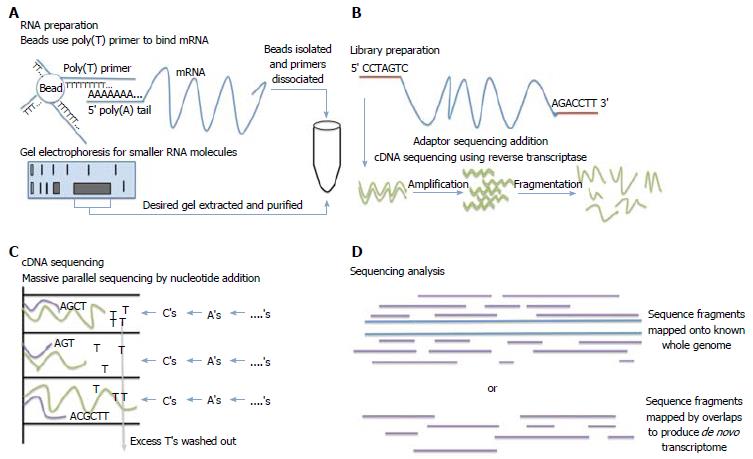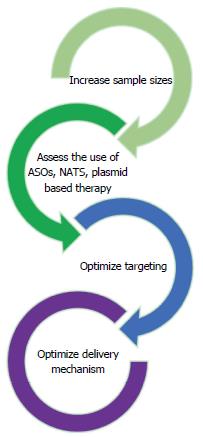Copyright
©The Author(s) 2017.
World J Gastroenterol. Apr 28, 2017; 23(16): 2819-2825
Published online Apr 28, 2017. doi: 10.3748/wjg.v23.i16.2819
Published online Apr 28, 2017. doi: 10.3748/wjg.v23.i16.2819
Figure 1 RNA sequencing steps.
A: RNA isolation techniques include the usage of beads with poly(T) primer tails to isolate mRNA or gel electrophoresis to isolate smaller RNA molecules; B: RNA libraries are prepared by attaching adaptors to isolated RNA strands, creating cDNA strands corresponding to the isolated RNA strands, amplifying the cDNA, and then fragmenting the cDNA strands; C: High throughput cDNA sequencing involves sequencing cDNA fragments in parallel by nucleotide addition; D: cDNA sequences are then analyzed by matching fragments onto known genomes or de novo mapping to produce a transcriptome.
Figure 2 Treatment options using RNA sequencing.
Many possible therapeutic applications of RNA sequencing in colorectal disease include gene therapy, antisense oligonucleotides, plasmid-based therapy, and natural antisense transcripts.
Figure 3 Roadmap of future studies.
It is proposed that the future of high throughput RNA sequencing applications in colorectal disease must address current limitations in the literature by creating studies with significant data by increasing sample size, focusing research on therapeutic applications of RNA, and delineating drug targets and delivery mechanisms.
- Citation: Gao M, Zhong A, Patel N, Alur C, Vyas D. High throughput RNA sequencing utility for diagnosis and prognosis in colon diseases. World J Gastroenterol 2017; 23(16): 2819-2825
- URL: https://www.wjgnet.com/1007-9327/full/v23/i16/2819.htm
- DOI: https://dx.doi.org/10.3748/wjg.v23.i16.2819











